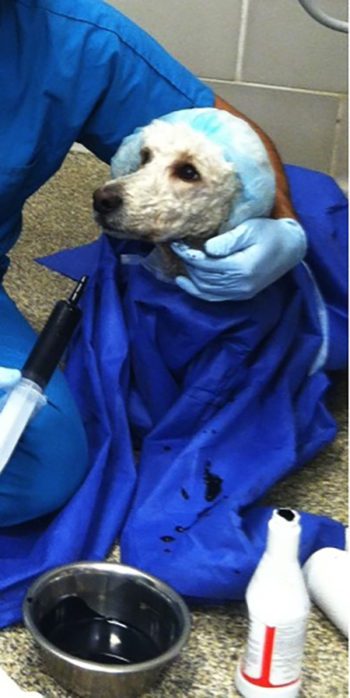26 Nov 2024
Nicola Robinson covers antifreeze to mince pies in this article for vets treating cats and dogs in general practice.

Image © lalalululala / Adobe Stock
With the weather cooling off and Christmas only weeks away, at the Veterinary Poisons Information Service (VPIS) we are preparing ourselves for the increase in calls we will receive relating to the colder season. Here, we will cover the general approach to poisoning cases and the most common calls received at this time of year.
Toxicology is a specialist area of veterinary medicine, and even the most experienced veterinary surgeon may find it difficult to assess the severity of a poisoning case. In 2023, the VPIS and Animal PoisonLine (APL) handled a total of 24,649 cases involving more than 39,000 toxic agents.
Although the most common ones are generally well known, vets in practice cannot be expected to know the risks posed by all the poisons they may be presented with. Added to this, time pressure during a busy consulting slot makes accurate decision-making more stressful.
The VPIS offers members 24/7 support and gives the treating vet confidence that they are handling the case properly. Vets have an unlimited number of free recalls for any case they have previously called about.
More than 360,000 cases are on the VPIS database and regular review of these, alongside research, ensures the advice given is accurate and up to date. The information the VPIS provides cannot be found elsewhere, with most of the toxic doses derived from case data analysis.
The first question to ask yourself is, “Do I need to treat?”, rather than, “What treatment should I give?”
Try to avoid having blanket protocols where all exposures to a certain toxin are treated (for example, rodenticides or xylitol) and do not guess that treatment is needed based on quantity. A few hundred tablets of a medication may not be an issue, while a couple of licks of a medicated cream could be fatal.
A thorough risk assessment should be carried out before reaching for an emetic or admitting the patient. It is tempting to think you do not have time, but, as long as the animal is asymptomatic or only showing mild signs, it is essential to ensure the case is managed appropriately and to achieve the best outcome for the patient.
Effective questioning of the owner is critical to understanding of exactly what toxin you are dealing with (Panel 1).
You then need to know what effect that toxin has on the patient’s species and if the dose is more or less than the toxic dose, which will dictate whether signs are likely to start.
If any doubt exists as to whether treatment should be started, or if you would prefer the VPIS to carry out the triage for you, it would be safe and appropriate in the majority of cases to refer the owner to APL (Panel 2), assuming the patient is not displaying significant clinical signs.
Decontamination is usually the first procedure to be carried out (after initial stabilisation, if this is needed).
The goal is to remove the toxin, prevent further absorption or exposure, and reduce the severity of the toxicity. If ingested, gut decontamination involves emesis, gastric lavage, activated charcoal or a combination of these.
It is important to note though that these treatments are not suitable for all poisoning cases and some may be ineffective or, indeed, contraindicated.
Two licensed emetics for dogs are available: apomorphine and ropinirole. Although, in some cases, emesis is useful, an over-reliance on this procedure exists in practice irrespective of whether it is indicated.
Emesis should not be routine following suspected poisoning. Only 40% to 60% of the stomach contents are retrieved after an emetic is administered, so it should not be the sole treatment. One study showed that gastric recovery of the total dose ingested was between 17% to 62% if emesis was induced within an hour of ingestion.
Therefore, several factors must be looked at before an emetic is given to a patient (Panel 3).
Gastric lavage may be the better option if it is unsafe to give an emetic, a large exposure of a very toxic agent has occurred or the patient has moderate to severe clinical signs that have developed quickly.
The role of activated charcoal is to physically bind to a poison and create an unabsorbable carrier, thereby preventing absorption into the bloodstream and promoting excretion. However, not all toxins bind to activated charcoal (Panel 4) and, as with emesis, timing is important. For toxins that do not undergo enterohepatic recirculation, one dose is indicated and should be given within two to three hours of ingestion.
For toxins that recirculate or for medications that are sustained release, further doses every four hours can be administered (up to a maximum of 24 hours).
Other treatments depend on the toxin involved, but several exist that the VPIS regularly advises for specific cases, and so may be worth either stocking or ensuring you can access in an emergency (Panel 5).
Many antifreeze products, as well as some screen washes and de-icers, contain ethylene glycol, which causes renal damage.
The toxic dose for companion animals is extremely low and differs between species, with cats being more susceptible than dogs. Initial signs usually start from 30 minutes and are non-specific, but include vomiting, ataxia and weakness. Blood gases showing a decreased blood pH can confirm suspected exposure and is evident by three hours.
Ethanol is one of the antidotes available and is very effective. It works by blocking the formation of the toxic metabolites. Ideally, a pharmaceutical grade of ethanol should be given, but if not available, an IV solution of either 5% or 20% can be made using 40% vodka, and administered with an in-line filter.
Fomepizole is an alternative antidote, but it is not readily available and is very expensive – especially for cats, which require a dose six times higher than dogs.
The longer the time to treatment, the less favourable the prognosis. Survival is most likely if treated within three to four hours of ingestion, and even a lethal dose of ethylene glycol can be survived if treatment is prompt.
In the case of cats, unless the ingestion was witnessed, they usually present in the final stages of poisoning (12 to 24 hours post-ingestion). Once renal failure is confirmed, antidotal therapy will be ineffective because antidotes increase the half-life of ethylene glycol, and if renal damage has already occurred, the kidneys may not be able to effectively eliminate it.

Cough, cold and flu treatment preparations are readily available, and in any cases of accidental ingestion each component of the preparation must be considered separately.
It is important to know the exact trade name and form (for example, capsules or sachet) of the product involved, so the ingredients can be assessed accurately.
They may contain the following:
Hand warmers can be air-activated packs containing metallic iron, salt, activated charcoal and vermiculite, or small liquid-filled pouches containing a floating metal disc (usually stainless steel) and a solution of sodium acetate.
Iron is corrosive to the gastrointestinal tract, but the severity depends on the formulation. Metallic iron has poor solubility and is, therefore, low toxicity. The amount ingested and patient weight need to be assessed, but treatment may not be required for these hand warmers.
Sodium acetate is low toxicity. Ingestion of the liquid from these hand warmers may cause mild gastrointestinal signs. The metal strip is a foreign body risk and not a toxicological hazard.

Demand for vitamin D supplements and prescribed treatments is increasing and they pose a risk to dogs that are very sensitive to some vitamin D compounds.
Certain analogues (found mainly in psoriasis creams) only require extremely small quantities to be ingested to cause significant toxicity or fatalities, whereas vitamin D supplements are lower risk unless a large number are ingested. Some supplements – particularly chewable formulations or oral sprays – may also contain xylitol.
Initial clinical signs occur within 12 hours and are fairly non-specific, but the main risk is hypercalcaemia and the potential for tissue calcification. Haematemesis is a poor prognostic indicator, as it may indicate severe gastrointestinal ulceration.
If treatment is required, it must continue for at least four days. If the calcium remains normal during this time, the patient can be discharged with no further risk.
Sources of salt toxicity during the winter are from rock salt used on roads and from homemade salt dough decorations.
The risk is hypernatraemia, which can be very serious if not treated. The toxic dose is low and emesis would need to be prompt to be effective. Activated charcoal does not bind to salt, so is ineffective in these cases. Electrolytes need to be monitored frequently for the first eight hours after ingestion and thereafter if the patient is symptomatic.
Correction of the acute hypernatraemia may be necessary and the sodium concentration can be reduced rapidly, which differs from cases of chronic hypernatriaemia. If you have a case of salt dough poisoning, call VPIS for more specific information and recommendations.
Ingestion of grapes or their dried fruits can cause renal failure in dogs and cats, but this only happens in a minority of cases (approximately 10%).
Recent research has indicated that tartaric acid is the toxic component and those affected lack the expression of renal OAT-4, which is the transporter needed to secrete the tartaric acid into the lumen for urinary excretion.
A toxic dose has not been established, but a single grape or dried fruit is unlikely to be a risk. Patients ingesting more than this should receive an emetic and repeat-dose activated charcoal, as well as having renal parameters monitored as a minimum. Twice maintenance IV fluids reduces the accumulation of tartaric acid and is an important part of the treatment protocol. However, if after being informed of the risks owners decline admission and the patient is discharged after gut decontamination, they should be instructed to return if signs start – particularly vomiting.
Symptomatic patients and late presenting cases should be admitted for treatment.

Found under or on the Christmas tree, as well as in advent calendars, December is a big month for chocolate ingestion for owners and patients alike. Around 20% of all chocolate cases reported to the VPIS occur in December.
The toxic component is theobromine, a methylxanthine, which affects the gastrointestinal tract and the cardiovascular and neurological systems. Dark chocolate is approximately four times more toxic than milk chocolate due to the higher concentration of cocoa solids. White chocolate does not pose a toxicological risk. Serious cases are not common, and deaths are rare (typically one case per year reported to VPIS). Prognosis is guarded in dogs with seizures or arrhythmias.
Christmas plants including holly (Ilex aquifolium), Poinsettia (Euphorbia pulcherrima), mistletoe (Viscum album) and Christmas trees (fir, spruce or pine) are low toxicity, and only cause mild gastrointestinal upset. Poinsettias have the reputation of being toxic, but this has been greatly exaggerated. All plants with sharp leaves or needles do carry the risk of mechanical obstruction, or physical injury, if ingested.
The signs of ethanol intoxication are similar to those in humans, but occur at much lower doses. Dogs develop behavioural changes, vomiting, ataxia, drowsiness, stupor and, in severe cases, respiratory depression, hypothermia and collapse.
Treatment is largely supportive. An emetic would need to be given early and only if the patient is asymptomatic, since the onset of clinical effects is usually rapid. Activated charcoal is ineffective.
Dogs appear to have a particular fondness for the expensive Irish whiskey and cream-based liqueurs. Among the cases reported to the VPIS, nearly 50% involved these types of drinks.
Most animals do make a full recovery within 12 to 24 hours with supportive care. They may be depressed and lethargic (or “hungover”) during recovery.
Leftovers from Christmas lunch or any roast dinner may contain stuffing, which usually has onions as an ingredient.
Although a fair amount would need to be ingested, dogs may develop toxicity in the form of Heinz body anaemia within one to five days of ingestion. Food bins kept inside also pose a significant risk if the contents become mouldy. Signs of tremorgenic mycotoxin toxicity often start within 30 minutes and are neurological.
An emetic (if vomiting has not occurred) and repeat dose activated charcoal are useful, but only if signs have not started.
Lipid emulsion works well for these cases, although care should be taken if using propofol to control signs, because it is also lipophilic and will be drawn out of circulation. A gaseous general anaesthetic would work better in these situations.